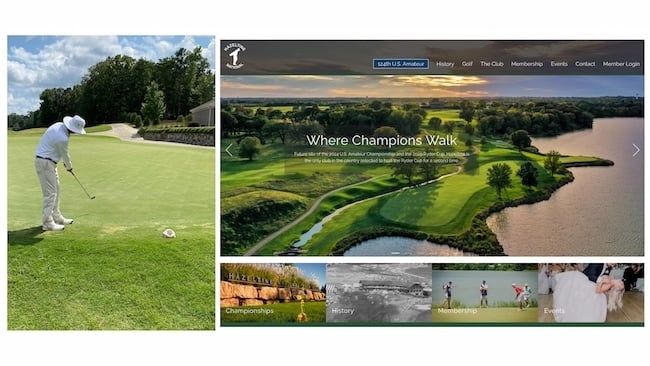5 Website Features That Help Private Clubs Attract New Members
Keeping your club’s waitlist full is no small task. Even with top-tier amenities and a strong community, if potential members can’t find your club...
"We don't really need a good website—we get most of our members from word of mouth."
I hear this all the time from clubs that are full or have strong waitlists. And look, I get it. When you've got a steady stream of referrals coming in, it's easy to think your website doesn't matter much. Maybe it's just there to give people your phone number and a few nice photos.
But here's what's actually happening: Even your best referrals are doing their homework before they reach out. They're visiting your site—sometimes dozens of pages deep—trying to figure out if your club is the right fit. And many of them never call. Not because they're not interested, but because your website didn't help them see themselves there or give them a clear path forward.
This isn't about generating more leads or competing with clubs that are struggling to fill membership. It's about not losing the qualified prospects who are already interested.
Let's rewind for a second. In the early days of the internet, most private clubs avoided websites altogether. As 501(c)(7) organizations, clubs can't "advertise" for members in the traditional sense without jeopardizing their tax-exempt status. So when clubs finally started building websites in the late '90s and early 2000s, they kept them barebones—maybe a photo of the clubhouse and a member login button. That was it.
If you wanted to learn about a club, you had to know someone who was already a member, or you had to show up in person and request a tour. The exclusivity was the point.
While most clubs have moved past the "photo and login button" approach, many still treat their websites as little more than digital brochures. They'll list amenities, maybe share some history, and call it a day. The mindset hasn't fully caught up to how people actually research and make decisions in 2025.
Here's the reality check: About half of U.S. clubs are currently at capacity. That's great news for those clubs. But it's also created a dangerous sense of complacency. I've talked to plenty of club leaders who think they've figured out the membership equation and can return to a referral-only model.
The problem? Industry experts are already predicting another downturn. When economic headwinds hit, referrals alone won't cut it—especially if you're trying to attract younger members with the financial means to join. Gen X and Millennials with disposable income for club memberships, second homes, and luxury travel don't make decisions the way their parents did. They research. They compare. They want to see themselves in your story before they'll consider reaching out.
Your website isn't just a courtesy for prospective members anymore. It's often your only chance to make a first impression.
Most club websites are built around one assumption: that visitors are ready to fill out a form or pick up the phone. But that's not how people operate anymore, even when they've been referred by a trusted friend.
Think about the last time someone recommended a restaurant or a vacation spot. Did you immediately make a reservation? Probably not. You looked at the menu online. You scrolled through photos. You checked reviews. You got a feel for the place before committing.
Prospective club members do the same thing. They've heard great things from a friend, but now they want to see if the club feels right for them. They're asking questions like: Will my family fit in here? Is this too formal? Too casual? Will my kids find friends? Can I get a tee time on weekends?
Your website needs to help them explore these questions naturally, without forcing them into a "contact us" funnel before they're ready. That means clear navigation, authentic imagery (not just empty golf courses and dining rooms), real stories about member experiences, and content that speaks to different personas—young families, empty nesters, serious golfers, social members.
Just because someone was referred by a member doesn't mean you have a lock on their membership. They may not be shopping five other clubs, but they're still evaluating whether your club delivers the experience they're looking for.
And here's the thing: An outdated or vague website raises questions. It makes prospects wonder if the club itself is outdated. It creates uncertainty about value. A modern, confident website, on the other hand, reinforces everything their friend told them and gives them permission to move forward.
I've seen clubs lose prospects simply because their website made them feel uncertain—even when the club experience itself was exceptional.
We work with clubs that track website analytics, and the data tells a consistent story: High-intent prospects visit 30, 40, even 50 pages on a website before deciding whether to reach out. They're serious. They're engaged. But somewhere along the way, they hit a dead end—unclear next steps, confusing navigation, forms that go nowhere—and they bounce.
This isn't a traffic problem. It's a conversion problem.
Your website should guide interested prospects toward action. That might look like:
A clear, easy-to-find "Schedule a Tour" page that doesn't bury visitors in form fields
A downloadable membership guide that collects basic contact info in exchange for detailed information
Clear differentiation—not just what your club offers, but why your club is the right choice for specific types of members
Smart forms that integrate with your CRM so no lead falls through the cracks
Testimonials or member stories that help prospects see themselves in your community
If your website doesn't do these things, you're not just missing out on new prospects. You're losing referrals who were already interested.
Let's say you're getting solid word-of-mouth traffic. That's fantastic. But if those leads aren't being tracked, followed up with, or understood, your pipeline stays leaky.
I've talked to membership directors who can't tell me where their last ten members came from. They know "referrals," but they don't know which referrals, from which members, or what convinced them to join. They don't know how many website visitors they had last month or which pages those visitors spent time on.
Without that data, you can't improve your process. You can't identify where prospects are getting stuck. You can't double down on what's working.
Your website should be more than a digital brochure. It should be the first step in a system that captures interest, nurtures it, and turns it into membership—even when you're not there to answer the phone.
Perception drives value. And a dated or confusing website quietly chips away at your club's perceived value.
Think about luxury brands. They don't cut corners on their digital experience. They understand that every touchpoint—including the website—reinforces whether their product is worth the price.
The same applies to private clubs. When a prospect visits your site and finds broken links, outdated photos, clunky navigation, or vague information, it creates doubt. Not about whether they can afford your club, but about whether your club is worth what you're asking.
A clean, intentional website helps reinforce that yours is the kind of club worth joining—without needing to discount your initiation fees or oversell your amenities.
Here's the truth: Referrals are still prospects. They're curious. They're browsing. They're trying to figure out if your club is the right fit.
Make sure your website reflects the real experience of your club, answers the questions they're asking (even if they don't vocalize them), and guides them toward taking action.
If your club is still relying primarily on word-of-mouth but you've noticed that inquiries have slowed, conversions feel inconsistent, or younger prospects seem harder to attract, your website might be the silent issue. It's not about abandoning the referral model. It's about making sure the referrals you're already getting don't slip through the cracks because your digital front door didn't do its job.
Your website should work as hard for your club as your membership director does. When it does, referrals stop being "just a nice tradition" and start becoming a competitive advantage.

Keeping your club’s waitlist full is no small task. Even with top-tier amenities and a strong community, if potential members can’t find your club...

In the competitive world of private clubs, your website serves as your digital front door, often forming the first impression prospective members...

Your club’s website should be the home and heart of your marketing efforts–the place to kindle all new and existing relationships. It can and should...